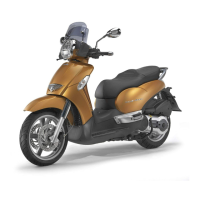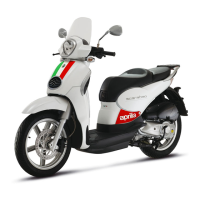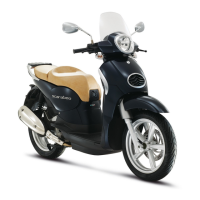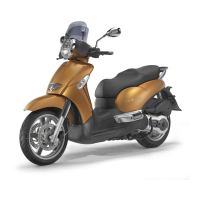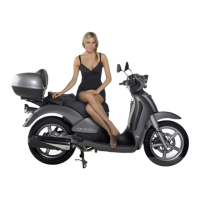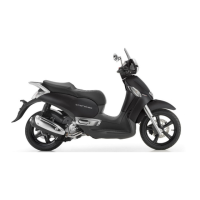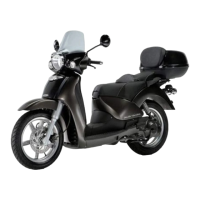
Do you have a question about the APRILIA SCARABEO 250 - 2006 and is the answer not in the manual?
| Brand | APRILIA |
|---|---|
| Model | SCARABEO 250 - 2006 |
| Category | Motorcycle |
| Language | English |
This manual is divided into sections, chapters and paragraphs. Procedures are laid out in single operation.
Details on controls like ignition switch, steering lock, and their operation.
Explanation of warning symbols (!, WARNING, CAUTION, NOTE) used in the manual for user safety.
Covers carbon monoxide, gasoline safety, and hot component precautions.
Precautions for handling used engine oil, including skin contact and disposal.
Brake fluid toxicity and handling precautions, including first aid and child safety.
Coolant flammability, toxicity, and handling. Risk of burns from hot coolant.
Battery gas explosion risk, acid hazards, and electrolyte toxicity. Safety measures during handling.
Essential advice on safety, training, and vehicle knowledge for rider safety.
Procedure for reporting vehicle defects that could cause crashes or injuries to NHTSA and aprilia.
Guidance on understanding and adhering to road regulations and proper vehicle usage.
Information on emission control system, origin of emissions, and exhaust system.
Prohibition of tampering with the noise control system by federal law. Examples of tampering.
Symptoms indicating potential vehicle emission issues and advice to consult a dealer.
Location and format of the Vehicle Identification Number (VIN) on the frame and identification plate.
Explanation of the alphanumeric codes and digits that constitute the VIN.
Diagram showing the placement of various warning labels on the vehicle.
Instructions and warnings for battery maintenance, safety, and gas hazards.
Maximum weight loads and warnings for accessories affecting safety and performance.
General riding safety, starting procedure, windshield care, and coolant warnings.
Labels covering fuel type, ignition, and federal safety compliance statements.
Manufacturer data, noise emission information, and tire safety warnings.
Details on emission standards, engine family, tune-up specs, and fuel/oil requirements.
Guidance on reporting safety defects to NHTSA and aprilia.
Diagram and list of components for the California evaporative emission control system.
Explanation of warranty rights, what the system includes, and owner obligations.
Details on warranty periods based on vehicle class and displacement, covering defective parts.
Owner's responsibility for maintenance, presenting vehicle for issues, and avoiding abuse.
Statement of warranty for new aprilia motorcycles, conforming to EPA and California standards.
Details on warranty coverage, including parts like carburetor, ignition, and emission-related assemblies.
Exclusions from warranty coverage, such as accident, misuse, improper repairs, or non-approved parts.
Liability limitations for aprilia and dealers, excluding inconvenience or consequential damages.
Clarification on express warranties, limitations on implied warranties, and state variations.
Information on specific legal rights granted by the warranty and potential state variations.
Instructions on repeating operations, understanding terms like 'right'/'left', and using spare parts codes.
Explanation of symbols used to indicate different vehicle versions (countries).
Overview of the manual's table of contents, listing all sections and pages.
Core safety rules for operating the vehicle, covering rider behavior and precautions.
Emphasis on protective clothing (helmet, jacket, gloves), rider condition, and training.
Rules for breaking in, checking controls, avoiding hot parts, and not riding under influence.
Importance of observing road signs, speed limits, and adjusting for conditions.
Advice on avoiding tailgating, understanding accident risks, not using leg guards, and proper control operation.
Emphasizes giving full attention to riding, avoiding distractions, and not smoking/eating/drinking while riding.
Use correct fuels/lubricants, check levels, and seek dealer inspection after accidents.
Prohibitions on modifying license plates or safety equipment, which voids warranty.
Warnings against engine modification and using non-approved accessories like sidecars/trailers.
Advice on proper braking, speed, acceleration, and engine braking for safe riding.
Guidance on safe cornering, adapting to wet/slippery surfaces, and avoiding aggressive maneuvers.
Importance of respecting speed limits, road signs, and emission limits. Avoid tampering.
Emphasis on proper, visible clothing, helmet fit, and avoiding loose items for rider safety.
Avoid sharp objects. Consult dealer for accessories. Avoid accessories that impair function or visibility.
Do not modify electrical system. Use only genuine accessories. Do not overload vehicle.
Secure all items. Avoid packs protruding or covering lights. Never carry children on luggage rack.
Carry passengers safely, ensure footpegs/handles are used. Be aware of reduced handling and increased risk.
Diagram and key identifying major external components of the vehicle.
Diagram and key identifying major components like helmet case, seats, fuel tank, and controls.
Diagram showing the location of switches, levers, and instruments on the handlebars.
Diagram of the dashboard showing gauges, warning lights, and indicators.
Table detailing the function of each warning light, indicator, and gauge on the instrument panel.
Description of horn button and turn indicator switch operation.
Description of dimmer switch, high beam flasher, engine stop switch, and starter button.
Details on the ignition switch functions: powering the vehicle, steering lock, seat, and glove compartment.
Instructions on how to lock the steering and the function of different key positions.
Instructions for displaying time, date, seconds, and setting the digital clock.
Information on the bag hook location and its maximum weight capacity.
Description of the antitheft hook and advice on using the optional shielded cable.
Step-by-step instructions for unlocking and locking the vehicle seat.
Instructions on how to open and lock the helmet case cover.
Instructions on how to open and lock the glove compartment and its weight limit.
Guide to adjusting the passenger seat position and a caution against tampering with the adjustment screw.
List of tools included in the toolkit found under the seat.
Critical safety warnings about gasoline flammability, toxicity, and proper handling and storage.
Steps for refueling the vehicle, including precautions and correctly fitting the fuel filler cap.
Critical role of lubrication, glove use for used oil, and careful oil filling.
Importance of brake function, warnings about worn brakes, and advice on wet conditions.
Information on brake fluid level, lever play, and warnings about contaminated disks or worn lines.
Critical safety advice for disk brakes, cleaning dirty disks, and fluid change intervals.
Procedure for checking brake fluid level, including precautions and actions if low.
Coolant toxicity, handling, and level checking. Disposal precautions and risks of overheating.
Precautions for handling coolant, its flammability, and mixture ratios for different temperatures.
Procedure for checking coolant level in the expansion tank and topping up.
Instructions for topping up coolant, checking for leaks, and refitting covers.
Tire types, importance of checking inflation pressure, and effects of over/underinflation.
Advice on tire wear, replacement criteria, wheel balancing, and recommended tire sizes.
Prohibition of tampering with the exhaust system and noise control laws.
Instructions to avoid injury or vehicle damage when getting on and off the vehicle.
Rules for passengers getting on/off, rider's role in maintaining balance, and judging traffic.
Detailed steps for mounting the vehicle, including foot placement and handling.
Detailed steps for dismounting the vehicle, including parking and balance maintenance.
Chart of essential pre-ride checks for brakes, tires, steering, fuel, coolant, and electricals.
Safety warnings for starting (exhaust fumes), procedure for positioning, and using controls.
Note on long inactivity, battery wear, and avoiding starter damage. Cautions on oil pressure light.
Tips for starting the engine in low temperatures, including throttle and starter usage.
Procedure for starting an engine that may be flooded with fuel.
Instructions for moving off, recommended riding position, and passenger safety.
Meaning of low fuel light and advice on using mirrors, especially convex ones.
Advice on smooth throttle control, braking techniques, and avoiding repeated throttle inputs.
Guidance on safe turning, downhill braking, and riding on wet or slippery surfaces.
Instructions for signaling turns, avoiding sudden stops, and proper braking for brief stops.
Rules for parking on firm ground, avoiding hazards, and not leaving the vehicle unattended.
Steps for stopping the engine, setting the ignition switch, and placing the vehicle on the center or side stand.
Instructions for locking the steering and removing the key after parking.
Advice on preventing theft, including using locks, parking securely, and keeping documents.
Overview of maintenance, owner responsibilities, dealer assistance, and pre-ride checks after service.
Safety precautions for maintenance: fuel, hot parts, ventilation, avoiding mouth contact, and using gloves.
Guidance on reassembly, fastener importance, torque values, and risks of overtightening/undertightening.
Chart detailing periodic maintenance tasks, intervals, and who performs them (user or dealer).
List of maintenance tasks to be performed by an aprilia dealer, with service intervals.
Importance of recording frame and engine numbers for parts purchasing and legal reasons.
Procedure for checking engine oil level, including safety precautions and correct measurement.
Steps for topping up engine oil if the level is low, with warnings about insufficient lubrication.
Instructions for inspecting, removing, and cleaning the air filter element.
Procedure for checking brake pad wear using visual inspection and tools.
Instructions for inspecting front fork oil and rear suspension, and cautions regarding brake pads.
Guide to adjusting the rear shock absorber spring preload for rider weight and conditions.
Table detailing rear suspension preload adjustments based on track alignment and road type.
Step-by-step instructions for removing the central inspection cover, with caution about tabs.
Instructions for removing the central fairing, including seat removal and screw removal.
Instructions for removing the front cover, with cautions about tabs and paint.
Instructions for removing the front inspection cover, including glove compartment access.
Steps for adjusting the engine idle speed, including connecting a rev counter and using the carburetor screw.
Procedure for adjusting the throttle twistgrip free play, including lock nut and adjuster usage.
Procedure for checking, cleaning, and changing the spark plug, including gap measurement and torque.
General safety rules for handling batteries, including risk of fire, acid hazards, and explosive gases.
Recommendations for battery care during long periods of inactivity, including charging and storage.
Steps for removing the battery case, including front cover and fuse block removal.
Procedure for checking and cleaning battery terminals and connections, and applying grease.
Instructions for safely removing the battery from its case and storing it.
Procedure for checking battery fluid level and topping up with distilled water.
Instructions for charging the battery, including recommended rates and post-charging checks.
Steps for reinstalling the battery, connecting cables, and refitting the case.
Procedure for checking and replacing fuses, with warnings about using correct ratings and short circuits.
Diagram and description of fuse positions and their respective electrical circuits.
Instructions for adjusting the horizontal beam of the headlight using screws.
Procedure for changing the bulbs for the turn indicators, including removing the lens.
Detailed steps for replacing low/high beam and parking light bulbs in the headlight assembly.
Instructions for changing the tail light bulbs, including parking/stoplight and number plate bulbs.
Safety measures for transporting the vehicle, including emptying the fuel tank and securing it upright.
Procedure for draining the fuel tank and carburetor for transport or storage.
Advice on cleaning the vehicle in various conditions, using low-pressure water and mild detergents.
Precautions for cleaning lights, plastic parts, and avoiding certain cleaning agents or methods.
Steps to prepare the vehicle for long periods of inactivity, including fuel, oil, and battery care.
Procedures after storage, including cleaning, battery check, and pre-ride checks.
Specifications for vehicle length, width, height, seat height, wheelbase, and ground clearance.
Details on engine type, displacement, bore/stroke, compression ratio, and starting parameters.
Specifications for carburetor model, frame type, steering head angle, trail, and suspension details.
Specifications for brakes, wheel rims, tire types, inflation pressures, and ignition system.
Specifications for spark plugs, battery, fuses, and generator.
List of bulb types, wattages, and warning light specifications.
Chart of recommended engine oil, transmission fluid, fork fluid, grease, and chain lube.
Specifications for brake fluid (DOT 4) and engine coolant (ethylene glycol).
Schematic diagram illustrating the vehicle's electrical wiring system.
List of numbered components and their identification in the wiring diagram.
Guide to the color codes used for electrical wires in the wiring diagram.
Information on the benefits of using authorized dealers and aprilia original parts.
Guidance on finding contact information for dealers and service centers via the aprilia website.

